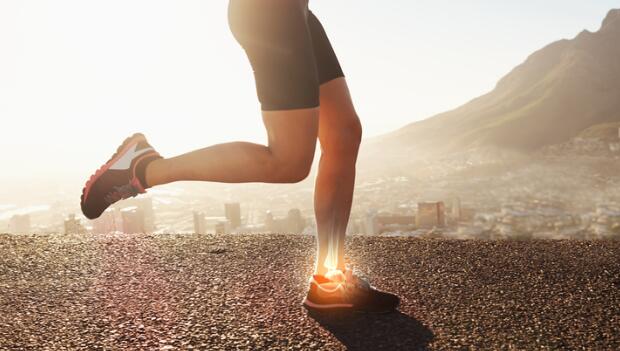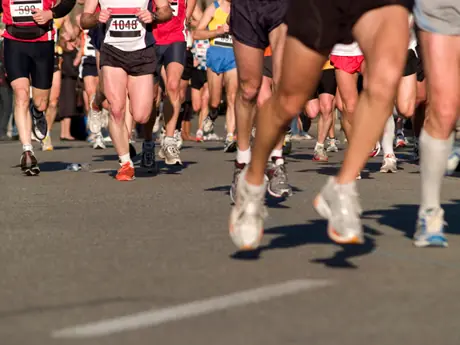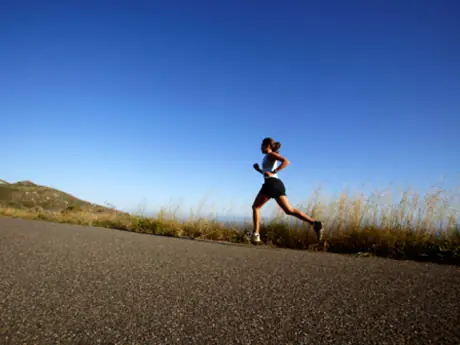
I first saw Dave in my office for heel pain. He had developed the pain two years ago and despite seeing other doctors, he had not had any improvement.
His running had suffered considerably. He used to compete in half-marathons throughout the year, but he was no longer able to run because of the pain. He insisted that he had done all the treatments available, but seemed hesitant to try a more aggressive approach.
He left the office with a home therapy regimen and some education on the importance of resting.
That weekend I spotted Dave running through the neighborhood, at quite a strong pace. At his next appointment I confronted him about his running and he confessed. He was currently running about 30 miles a week, about half of his weekly mileage two years ago. During the summer months he used to run 70-80 miles a week while preparing for marathons. Thirty miles a week seemed like resting to him.
Dave's behavior is common among athletes. Sticking with a routine and ignoring the pain is typical. An injury can be devastating, even for recreational athletes. Many avoid the doctor for fear of what they may find out.
Many injuries require six to eight weeks of rest, and that is not what an athlete wants to hear. With a high tolerance for pain, athletes will frequently train through the pain. Unfortunately, this tends to make injuries worse, particularly when it comes to the foot.
According to Running Research News, a million runners develop heel pain (plantar fasciitis) every year. The American College of Foot and Ankle Surgeons has stated that heel pain has reached epidemic proportions in weekend athletes.
This common condition is typically ignored, especially by athletes who tend to seek treatment only after the problem becomes severe. Starting treatment early will help prevent the problem from becoming chronic and limiting activity for 8 to 12 months.
Heel Pain After Running: Causes
Overuse, foot structure, and even shoe type can all contribute to heel pain after running. People who have flat feet or very high arches often experience heel pain after running because these foot shapes may put strain on the plantar fascia, a ligament that runs along the bottom of the foot.
Plantar fasciitis is the tearing of a ligament on the bottom of the foot where it attaches at the heel. The tearing causes inflammation and the inflammation causes pain.
Pain is felt at the bottom of the heel and sometimes in the arch and usually is the worst at the first step in the morning, but may also occur only during or after a run or activity.
Plantar fasciitis is not typically caused by a direct injury or trauma, but commonly the result of running or walking in a worn-out pair of running shoes, training on a new surface or adding hills into a routine.
Heel Pain After Running: Treatment
At the first sign of pain in the arch or the heel, consider the following:
- Rest. No running, walking, treadmill or stairmaster. Cross-train by biking, swimming, yoga (no downward dog) or weightlifting (avoiding squats and calf exercises).
- Ice. Take a sports water bottle, put it in the freezer and roll your arch over it for 20 minutes every evening.
- Stretch. Stretch your calf multiple times throughout the day. Use a belt or a towel to stretch your calf in the morning, BEFORE you get out of bed for 30 seconds to a minute. Perform the runner's stretch (with both hands against a wall for support, extend one leg behind you, keeping that heel on the ground, and lean forward slightly to stretch your hamstrings/calves) as many times as you can throughout the day for 30 to 60 seconds (I tell my patients 10 times a day).
- Wear Shoes. Make sure you are in shoes all the time. No going barefoot. Wear shoes that are rigid and bend only where the foot bends, at the toes. Test your shoes by turning them upside down, grabbing the toe and the heel and bending them. If they fold in the middle—throw them away. They may have caused your pain.
Many shoe companies are designing shoes to be lightweight. This compromises the stability in some brands and results in a breakdown of the shoe within a few months after purchase. Testing your shoes often for stability will help avoid injuries.
If your pain does not resolve in two weeks, visit your podiatrist. Other treatments may include anti-inflammatory medications, night splints, steroid injections, pre-fabricated or custom-made orthotics, castboots, shockwave therapy or surgery.
Heel Pain After Running: Prevention
To avoid developing plantar fasciitis, make sure that you are always training in good running shoes. If the shoe starts to wear down on the heel, your foot will take on abnormal stresses and will have a higher chance of injury.
If you have flat feet, consider buying a pair of sport orthotics at your local running store or sports store. Try to run on soft, even surfaces. Running on a sloped concrete surface will increase the chance of injury. Add mileage slowly and incorporate hills gradually.
If you find that you are prone to heel pain, try changing these factors:
- Footstrike Patterns: Where your foot strikes the ground with each stride matters. Many people have a rearfoot or heel-striking strike pattern, which may contribute to heel pain. Consider shifting your strike pattern to the midfoot or forefoot.
- Running Surfaces: Running on grass, dirt, and rubber tracks cushions your feet and reduces pain. If you must run on hard, flat surfaces, the right running shoes can help.
- Running Shoes: Choose running shoes that support your foot structure, have good arch support, and an elevated heel. If you have flat feet, you may be more prone to pain. Invest in running shoes for people with flat feet.
- Stretching: Try to stretch to loosen up your muscles before and after running.
- Weight: Maintaining a healthy weight can help you feel lighter on your feet, improve balance, and build core strength, all which help you maintain healthy movement patterns. This in turn can keep pressure off your lower body and reduce pain when running.
 READ THIS NEXT: How to Prevent and Respond to Runner’s Knee
READ THIS NEXT: How to Prevent and Respond to Runner’s Knee
Christine Dobrowolski is a podiatrist, runner and author of "Those Aching Feet: Your Guide To Diagnosis and Treatment of Common Foot Problems," available via her publisher, Ski Publishing, and at Barnes & Noble and Amazon.com.
Get ACTIVE on the Go


Couch to 5K®
The best way to get new runners off the couch and across the finish line of their first 5K.
Available for iOS | Android







Discuss This Article